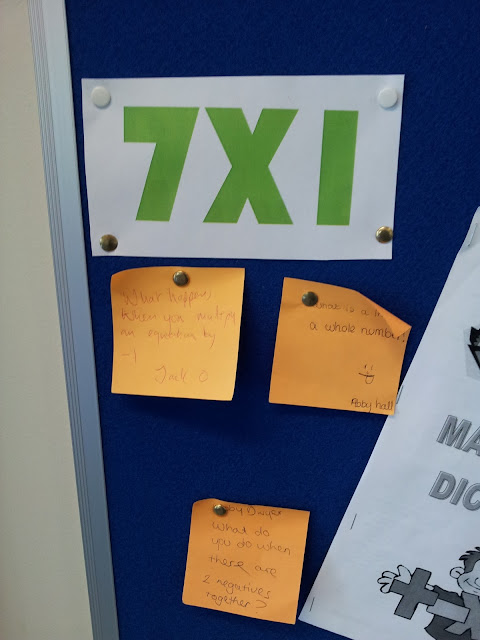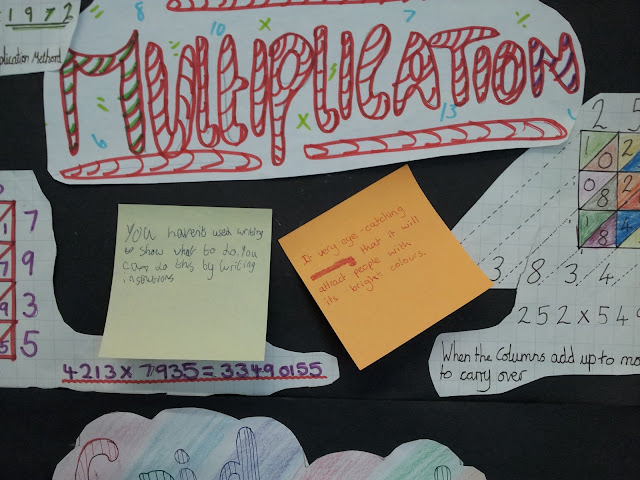So here are 5 suggestions of things we've done, with examples & pictures of how we've used them.
Some of these are ideas proudly magpied from various places (twitter being a big one!), others we came up ourselves with but of course they could easily have been in existence elsewhere. I'm not crediting sources here not because I am claiming them for myself - it's just because we've lost track of where these ideas have come from. If you feel strongly about ownership of any of these ideas then please feel free to claim anything via the comments at the bottom.
1) Graffiti revision wall
Get some lining paper, or some other big sheet of paper to put up somewhere in your room to use for this.
While revising if a student finds something that they think would be useful to them, or someone else in the class in the future or they can go and write it on the board. If they are uncomfortable writing it up directly they can ask me to do it (though they have to say exactly what to write) or put in on a smaller piece of paper that is then glued on. Also of a student feels they can explain an idea in a better way they can replace work on the board by sticking a replacement over the top.
After a week or so mine looked like this:
One of our SLT saw it on the wall and made a quip about me "not being at college when they covered display work." I pointed out that it's meant to be dynamic, organic and USEFUL, not pretty! He accepted the point!
I ran it with two fairly low ability groups and they liked the fact that they could control what went up on the board, and that they could refer back to it when they needed. it was really nice to see it develop over a series of weeks.
2) Question boards
Similar vein to the graffiti wall but not quite so imposing. We have had different versions running in the department.
One looks like this:
When a student in the class asks a question and then finds out an answer they write their question and their name on the post-it. If another student in the class asks the same question they are directed to the board to find out who in the class knows the answer so they can go and ask them. Here are some examples:
This helps to remove the perception that the "teacher is the holder of all facts", and encourages sharing of info between students.
Another alternative is this:
Students use a small piece of paper either to write a short guide on a key topic (with an example), like this:
Alternatively they can write a question that's puzzling them and others in the class can go up and answer them, like this:
3) Student comments on display work
Again making displays interactive. Work is done for display and then put on the wall. The students are then encouraged to comment on the work with post-its that are added to the display. Where appropriate the teacher can clarify or add to comments made by adding an extra, different coloured post-it.
The whole effect looks like this (student comments in yellow and orange, teacher comments are the green arrows):
4) Use more of the classroom as a whiteboard
I've seen several people suggesting using windows as whiteboards - we've used them with students writing on them like this:
Teachers have also used them to pose questions (different questions on different windows - for differentiated tasks) - like this:
If you've not got windows that are suitable/accessible then you can get a product called "instant whiteboard". It comes on a roll and sticks to almost any surface like clingfilm. Students can use it to discuss and share ideas:
Or teachers can use it to set work for a specific group of students:
5) Key word bank
Only actually used in one of our classrooms but I'm looking to spread it further. Think primary schools use this type of thing a lot.
Fairly self explanatory - it looks like this...
6) Measuring progress against revision topics
This is another one that is supposed to be dynamic and USEFUL rather than pretty!
Linked heavily to the "passport to grade" resources by Mr Slack found here, but could be used with any topic list. Key topics displayed on the wall. When a student demonstrates proficiency in a topic they get a stamp in their passport and can go and sign the wall next to the topic. They then become an expert on that topic so if others in the class need help they can look at the wall and go and ask the relevant student.
After a few lessons it looked like this:
The students liked signing up and seeing their names up on the board. Next time I do this I was thinking of having key assessment/example questions for each topic attached next to the topic name. Might also include a QR code linking to online revision resources.
Hope this was useful
Hopefully you've seen something you might use, or perhaps it gave you an idea for something else? Either way - all thoughts & comments gratefully received.


















